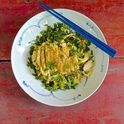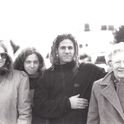Can I use a dry measuring cup to measure liquid ingredients for my bread maker?
16 Comments
Chrissy G.March 24, 2018
I only have dry measuring cups how many of the dry cups do i need to equal 1 cup of water plz help I can't find the answer any where
Voted the Best Reply!
SmaugMarch 24, 2018
This is a weird discussion -they are the same. The dry cups are made to allow leveling off, more convenient for dry ingredients and the liquid cups for pouring off- more convenient for liquids. When measuring water in a dry cup, there will be a small meniscus that will theoretically affect the measure very slightly, but the amount sticking to the cup will negate it and it's negligible- certainly for bread- anyway. All the discussion of weights is irrelevant. A liquid ounce of water does equal an ounce of weight, as a liter of water weighs a kilo, but it has nothing to do with how you use measuring cups.
DropletJanuary 26, 2014
They are not the same and it does make a difference. That being said, with bread making there are other factors involved which might compensate for or underscore the small difference, like, for instance, the type of flour you use. My parents own a bread machine and the measuring cup that it came with has the dry measure on one side and the liquid measure on the other, depending on how you look at it.
PeggyJanuary 26, 2014
It shouldn't make any difference whatsoever! Both dry and liquid measuring cups measure by VOLUME, not WEIGHT. Fill a half-cup dry measuring cup with any liquid, then pour it into a liquid measuring cup. You will see that it will still measure one-half cup.
boulangereJanuary 26, 2014
With liquid measure, Peggy, weight and volume are equal. 8 ounces of milk in a fluid measure is equal to eight ounces by weight. Such is not the case, clearly, with dry measures.
Devangi R.February 16, 2012
Boulangere is absolutely right... But, if u don't have liquid measuring cup, I think so u can use coffe machine kettle if u have one and if it has measuring indicators...later on u can buy one..
susan G.February 4, 2012
If you want, for instance, 1/4 cup of water, the 'dry' 1/4 cup measure will hold 2 fluid ounces which equals 1/4 cup, if you fill it to the top. You can't level off the liquid, so 'to the top' is not perfect. It's not likely that your set of dry cups are calibrated other than the full measure, with the exception of the 1 cup, so in-between amounts involve some guesswork, so they aren't exact. There are advantages to using a cup meant to measure liquids -- you get the full range of indications from bottom to top, so you can be more accurate. Also, most of them also have milliliter/liter indications if your recipe has metric measures.
The English language has the confusion mentioned by boulangere -- an ounce of liquid and an ounce by weight are using different systems, so you can't equate one to the other. Good cooks are moving to weight measurements, because they are more accurate.
The English language has the confusion mentioned by boulangere -- an ounce of liquid and an ounce by weight are using different systems, so you can't equate one to the other. Good cooks are moving to weight measurements, because they are more accurate.
boulangereFebruary 4, 2012
Yes, NeuB. Fluid (wet) measuring cups tend to be graduated in (fluid) ounces, and have a pouring spout. Day measuring cups are level from across the top. WAY different one from the other. Great question, and so glad you asked. I hope the explanation improves your baking prowess!
boulangereFebruary 4, 2012
Sorry, "dry" measuring cups, not "day". As in day or night, dry is dry.
boulangereFebruary 4, 2012
No. Never. For example, 1 dry cup of sugar equals 7 ounces. One fluid cup of milk (or sour cream, or cream cheese, or eggs) equals 8 ounces. Small differences make a big difference.
boulangereFebruary 4, 2012
At the same time, one cup of bread flour "weighs" between 4-4.5 dry ounces. That can't possibly equate to 1 fluid cup of milk or water which equals 8 fluid ounces. Dry, fluid, never the twain shall meet.
Mr_VittlesFebruary 4, 2012
You CAN always use dry cups when measuring wet ingredients, its just less accurate.
Showing 15 out of 16 Comments
Recommended by Food52
Popular on Food52
Continue After Advertisement




